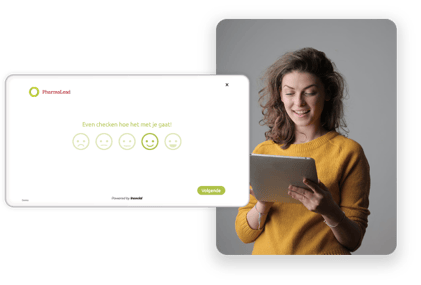Unhappy employees are incredibly detrimental to your organization. Think about the phone call with a rude customer service representative that you've probably had. Or staff who give you no attention at all when you walk into your store. Customers are more likely to do business with a competitor because of this poor service. Happy employees, on the other hand, are the key to success. They are more motivated, more productive and go the extra mile to satisfy customers.
This shows that Employee Experience is an important part of Customer Experience. EX = CX!
But how do you know if your employees are happy with you as an employer? You can find out by asking the eNPS!
What is the eNPS?
If you are already familiar with the NPS, then you know that this is a powerful KPI for gaining insight into customer loyalty. The eNPS is a KPI that you ask in an MTO (employee satisfaction survey) to gain these insights (in satisfaction and loyalty) as well, but then about your employees. With such an MTO, in which you ask your employees questions by means of a survey, you find out how your employees are doing. The eNPS consists of the question:
"On a scale of 0 to 10, to what extent would you recommend us as an employer to individuals within your network?"
The benefits of the eNPS
But why exactly would you want to know this? Well, because someone will only recommend you as an employer if they are truly satisfied at your organization. An unhappy employee is not likely to say to a friend "do you know where you should work? At our company!". Thus, it says something about how happy someone is with his or her employer. And why is it of value that your employees are happy? Happy employees are much more engaged and go that extra mile for the company and its customers. Research also shows that happy employees do about 12% more work in the same time as dissatisfied employees. They are therefore more productive. Happy and engaged employees are the foundation of a successful organization.
Promoters, passives and detractors of the eNPS
As with the NPS, responses to the eNPS question are divided into three categories.
Promotors (9-10)
The employees who give your organization a 9 or a 10 consider themselves fans of yours. They are happy to recommend your company as an employer to acquaintances in their network. These are engaged employees who are also proud to work for you.
Passives (7-8)
An employee who gives you a 7 or an 8 as an answer to the eNPS question is definitely satisfied with his or her current job. But, there are also a few areas for improvement, according to this employee. These areas for improvement, however, are so important that they would not yet recommend you as an employer. Somehow they think the grass is greener elsewhere. A great opportunity for an organization to find out what they need to improve and to see if they can be resolved.
Detractors (0-6)
Employees who give your organization a low grade are very dissatisfied. These employees are not happy and are about to leave your organization. Whether this is a bad thing? Not always. Sometimes a switch of employees is good for a company. But do you have a high turnover of employees? Then it is wise to conduct exit interviews with these detractors, for example. Why do they want to leave? What do these employees find important that you cannot offer them? This in turn will help you find the right candidates in the future.
Trade-off: to offer anonymity or not?
In order to get honest and not socially desirable answers from your employees, it is very important to make your survey anonymous. An employee is unlikely to give you a rating between 0-6 (detractors) if they know their boss is reading it. When you can ensure anonymity, employees are more likely to indicate what they really think of your organization.
A disadvantage of anonymity is that you do not know who said what. You can of course ask at the end of the survey if the employee would like to continue talking about his or her answers. In this case, give the respondent the option to fill in his or her details. The detractors may not do this, but the passives will. And you can certainly engage them in conversation for valuable depth. Furthermore, even though your survey is anonymous, you can of course share the average results with employees.
Share the results and start improving
Even though your survey is anonymous, you can of course share the average results with employees. After all, your employees participate in a survey and give your organization input by answering questions. It is therefore desirable to receive feedback. Therefore, send the average results and the associated improvement plan (plan where in stat you will work on) to your employees. This way, employees know that you take their answers and feedback seriously and that you are really going to do something with it!
Another advantage! By giving feedback on your MTO, your employees will be more inclined to fill out your next survey, for example a quick check after a few months (we call these pulse surveys). In this way you keep a finger on the pulse and always have insights into the satisfaction of your employees.




